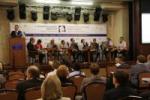- عربي
- Ukraine
- Economy
-
Investment
- Current Investment Trends
- Legal Conditions of Doing Business
- Investment Policy
- Competition
- Setting a Business in Ukraine
- Mergers and Acquisitions
- Taxation
- Import and Export
- Banks and Bank Regulation
- Convertibility and Profits Repatriation
- Currency Regulation
- Protection of Intellectual Property Rights
- Companies
- Travel to Ukraine
- About us
- Useful Sites
- Gallery
- News
Currency rates in UAH
| AED | ||
| BHD | ||
| EGP | ||
| KWD | ||
| LBP | ||
| OMR | ||
| QAR | ||
| SAR | ||
| SYP |
2015-07-06
| Kiev |  |
+32 |
| Donetsk |  |
+28 |
| Dnipropetrovsk |  |
+31 |
| Lviv |  |
+31 |
| Odessa |  |
+27 |
Ukraine in the Second World War
According to the clauses of the Riga peace agreement, Eastern Halychyna and Western Volyn were parts of Poland. The Polish government did not give the Ukrainians the rights of autonomy. During the land reform, Polish land owners (mostly former military officers) obtained the best plots of land. About 200 thousand of them were distributed in overpopulated areas of Western Ukraine from 1920-1938. The colonization and assimilation policy of Polish powers called for the resistance of population, ruled by two opposite underground organizations: the Communist party of Western Ukraine and the Ukrainian military organization. Early in 1929, the Organization of Ukrainian nationalists (OUN) was created in Vienna.
On September 1, the attack of Poland by Adolf Hitler marked the beginning of the Second World War. Almost simultaneously, Stalin attacked Poland on September 1 from the east and occupied the greatest part of the country’s territory: Western Bielorussia and Western Ukraine. In June 1940, Stalin tookBessarabia, and Northern Bukovyna was annexed by Romania in 1940. After the reunification of the Ukrainian SSR and Western Ukraine, the population grew by 8,909 and by the middle of 1941, the population stood at 41,675,000.
The republic territory became 560 thousand square miles. The sovietization of the newly-created western regions began. All the political, national economic and cultural infrastructure that was created by Ukrainian intellectuals and businessmen was annihilated. About 10% of the Western population was repressed, and the population sharply felt the lack of freedom with which the totalitarian regime had embraced them with.
On June 22, Germany and its allied powers invaded the Soviet Union from three strategic directions. Having had no experienced military leaders, the Red Army suffered great losses and the soldiers often found themselves surrounded. By the end of September, the Red Army left Odesa, and in the middle of October the battles were expanded near Kharkiv and Donbas.
The Soviet Union suffered great defeat, which cast doubt in the state’s existence and the fate of its people. Hitlerites considered the territory of Eastern Europe, including Ukraine, as the life space (Lebensraum) for German people. Mad racist theories of Fuhrer, which materialized in his general plan “Ost” were soon realized.
In December 1941, Wehrmacht suffered its first defeat near Moscow. In the course of counterattack, the Red Army drew the Germans back for 400 km. Nonetheless, 1942 was still unsuccessful. The catastrophe near Kharkiv, where three armies were surrounded and crushed was one of the greatest tragedies. Sevastopol fell in July, and on the 22nd, the receding Soviet troops left the last settlements in the territory of Donbas. The enemy penetrated the Caucasus and the banks of the Volga in the region of Stalinhrad.
Hitler gave a considerable portion of Ukrainian land to his ally, I. Antonesku. They created a new Romanian province called “Transnistria”, with a center in Odesa. West-Ukrainian lands were subject to governor-generalship which embraced the greatest part of Poland. The Right Bank and the greater part of the Left Bank, and areas adjacent to the Crimea, created “Reichscommisariat of Ukraine”.
Terror swayed in the lands occupied by Germans, who completely exterminated Jewish and Gipsy populations, as well as all other people suspected of not being loyal to the Reich. Thousands of people starved to death because the occupying powers didn’t care to supply food to the towns. In 230 camps for war prisoners, 1,366 people died, most of whom starved to death. Ostarbeiters, in a number close to 2.4 million, were taken off to work in forced labor camps in Germany. Nearly 320 villages, with people still dwelling in their homes, were burned down. About 6 million Ukrainians served in the armed forces of the anti-Hitlerite coalition of countries. Of them, about 3 million died, and every other person became an invalid. Between 7-8 million people, born in Ukraine perished during the war.
Partisan movement in Western Ukraine was lead by the OUN. On the eve of the war, OUN split into two parts, which seemed to disagree with each other. They were the OUN(b), headed by S. Bandera, and OUN(m), headed by A. Melnyk. When German troops had occupied Lviv, Bandera and his adherents announced “Act to restoration of the Ukrainian state”. A provisional government was appointed, headed by Y. Stetsko. When Berlin authorities came to know about the unwarranted actions of the nationalists, the government was driven away and the OUN leaders found themselves in concentration camps. After two tides of arrests and executions (in September and December 1941), the OUN under Bandera went underground.
In the autumn of 1942, Bandera’s OUN decided to create the Ukrainian Insurrection Army (UIA), called upon to fight with the Polish and Soviet partisan-underground formations. Banderists defended the local population from occupying forces and periodically entered into armed conflicts with them. As a whole, the command maintained its troops in the state of armed neutrality. They were guided by the pragmatic desire to spare their strength for the struggles with the Red Army, since it became apparent that it would return.
After the defeat in Stalinhrad, a division of sich gunman, “Halychyna” was created at the initiative of German authorities. This was a typical example of collaboration. Cooperation with nazism doomed to defeat in the war could not give anything the to the Ukrainian cause. The Stalinhrad catastrophe created preconditions for mopping up the territory of Ukraine from the occupants.
On December 19, 1942, the enemies were dislodged from the first Ukrainian villages. After the victory on the Kursk Bulge in July 1943, Soviet troops counterattacked and quickly liberated Left Bank Ukraine and Donvas. Kyiv was liberated on November 6, 1943.
In October 1944, the entire Ukrainian territory was free from enemy forces. Transcarpathian Ukraine was liberated on October 26-28. In November, the congress of people’s committee in Mukacheve made a resolution about the Transcarpathian withdrawal from Czechoslovakia and its reunification with Ukraine. The new region expanded Ukraine’s territory to 577 thousand square miles.
After landing American and English forces in Normandy in June of 1944, the defeat of Germany became inevitable. The Berlin operation, in which the troops of the 1st and 2nd Bielorussian and 1st Ukrainian fronts took part (total of 2.5 million people), became the last page in the war. On May 9, 1945, the statement of unconditional capitulation was signed in the presence of Soviet, American, English and French representatives.
The results of the war and the postwar world order were determined by mutual actions of the countries of the anti-Hitler coalition (first of which were the Teheran and Crimean conferences). The conference in San Francisco in June 1945, founded the United Nations organization. Ukraine and Bielorussia, the union of republics of the USSR which had made a recognizable contribution to the defeat of nazism, were among the founding nations of the UN organization.
Material losses of the USSR during the Second World War surpassed 40% of total expenditures of the belligerent powers. The part of the Ukrainian SSR in the All-Union losses surpassed 40%. Ukraine suffered greater material losses than Russia, Germany, France or Poland.



